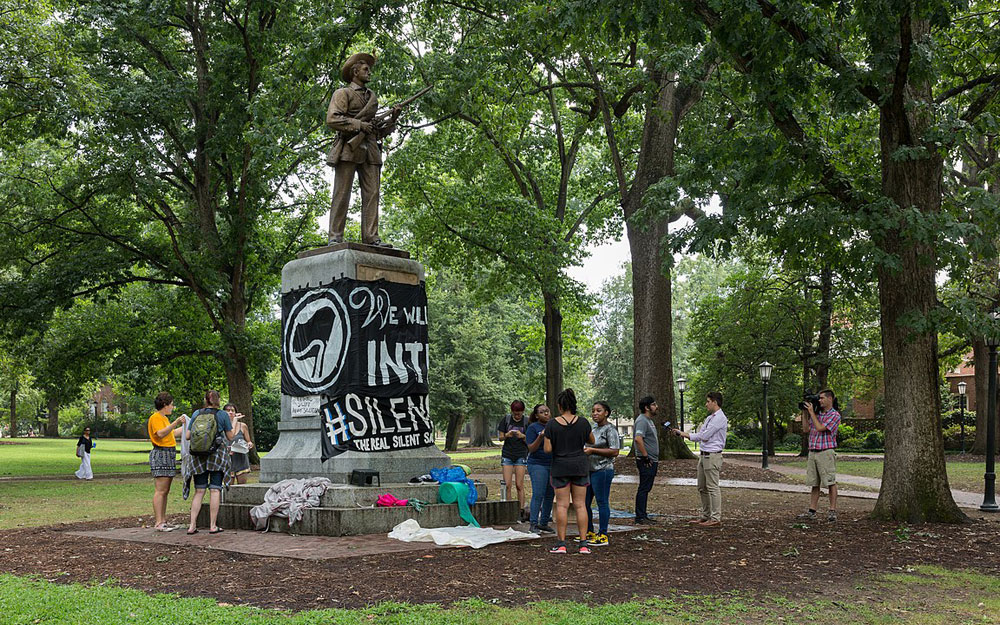
February 14, 2020; New York Times and The Root
Last week, the University of North Carolina (UNC) system’s board of governors learned a hard lesson. An agreement they hoped would quietly end the saga of “Silent Sam,” a monument erected to honor Confederate soldiers, was voided by Judge Allen Baddour of the Orange County Superior Court. With this decision, UNC finds itself again facing the reality of slavery’s legacy and those who wish to sweep it away.
Erected in 1913, “Silent Sam” is one of hundreds of monuments erected long after the Civil War ended in a sweeping effort to sugarcoat the bitter legacy of the South and consolidate Jim Crow racial segregation. According to James L. Leloudis, a professor of history at the University of North Carolina at Chapel Hill, as reported by the New York Times, “Today, people often read the monuments as veterans memorials. But the people who erected the monuments went out of their way to make it clear that they honored the living as well as the dead, and most particularly, those ex-Confederates who returned from war and committed themselves to the long, bloody, and ultimately successful effort to re-establish white supremacy.”
For more than 100 years, Sam stood quietly on the UNC campus, proclaiming the nobility of fighting for the South’s cause and ignoring the horror of enslavement. The university allowed him a place of honor until 2018, when protesters tore Sam down, spurred by the national awakening to the reality these statues tried to hide.
Those supportive of Sam’s message quickly responded with their own protests. Citing a state law passed in 2015 forbidding the removal of monuments from public spaces, the Sons of Confederate Veterans, an organization that believes “the citizen-soldiers who fought for the Confederacy personified the best qualities of America,” threatened to go to court to force UNC to return Sam to his place on campus.
The board of governors temporarily removed the statue to a safe, nonpublic spot while a resolution was sought. They hoped they could satisfy everyone without being forced to choose sides. They ignored the need to answer, as Diandria Barber noted for NPQ, African American students and faculty as they asked, “Will reconciliation ever really take place?” In other words, they wanted to make the issue go away.
Sign up for our free newsletters
Subscribe to NPQ's newsletters to have our top stories delivered directly to your inbox.
By signing up, you agree to our privacy policy and terms of use, and to receive messages from NPQ and our partners.
Quietly, and with no public process, UNC reached an agreement with the Sons of Confederate Veterans. The Sons would be given the statue and a $2.5 million endowment so they could place it in a new public site. The threatened suit would go away, and the statue, though not on campus, would still stand. Ripley Rand, a lawyer for the board, explained the university’s approach: “The Board of Governors knew from the very beginning that this was a difficult but needed solution to meet all their goals to protect public safety of the university community, restore normality to campus, and be compliant with the Monuments Law.”
The hope that there was a way to make everyone happy was soon dashed. The university soon found itself facing a suit from Sam’s foes:
Carl Adkins, a retired judge and one of the first black students to graduate from the university, was among a number of prominent alumni and donors—including Taylor Branch, the Pulitzer Prize-winning biographer of the Rev. Dr. Martin Luther King Jr., and Carla Overbeck, the former Olympic soccer captain—who joined a legal brief arguing the deal “seriously damages the reputation of the university, which should be committed to historical truth and opposed to modern-day white supremacy.”
William Sturkey, a historian at UNC Chapel Hill who specializes in the history of race in the American South, went even further in comments to the Times, calling the university’s actions “a clear case of corruption” between the board, whose 24 voting members were elected by the North Carolina General Assembly, and the Confederate group. “We need more rational, clearheaded voices—not just a small group of people making a back-room deal with a white nationalist organization,” he said. F. Sheffield Hale, the president and chief executive of the Atlanta History Center, which encourages community-driven discussions about Confederate monuments, made this point even more forcefully: “Chapel Hill is a special case, and it’s particularly special because it’s been going on so long, and it’s so heated, and every time they’ve tried to solve it, they’ve chosen the clumsiest way possible and made it worse.”
For Kristen Clark, president and executive director of the Lawyers’ Committee for Civil Rights Under Law, in comments reported by The Root, “This is a victory for students and faculty across the University of North Carolina system and for the people of North Carolina who viewed this settlement as fraudulent and the transfer of financing to be in direct conflict with the university’s mission.”
The board of governors must now know that it’s hard to finesse or dismiss difficult issues. Their desire to avoid having to own a position for fear of reprisal from those who disagree may be understandable, but it is untenable. This board, and every nonprofit board facing a similar choice, can neither abstain nor play ostrich. They need to decide what their mission calls upon them to do, what their obligation to be good institutional stewards calls upon them to do, and then act.—Martin Levine













